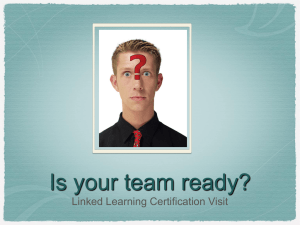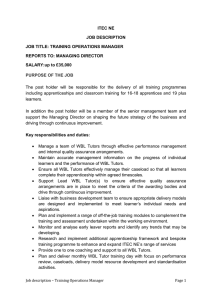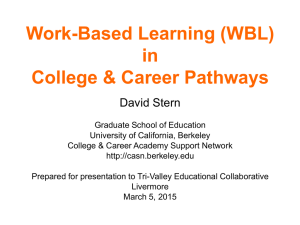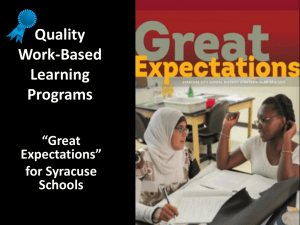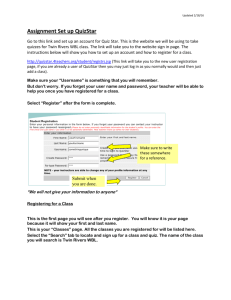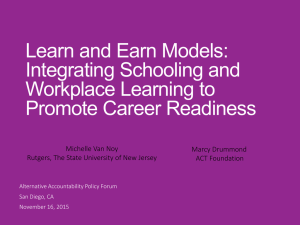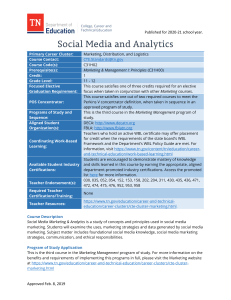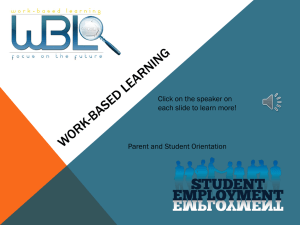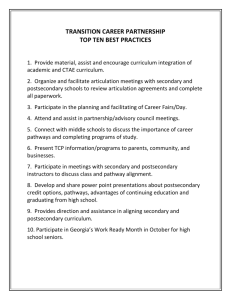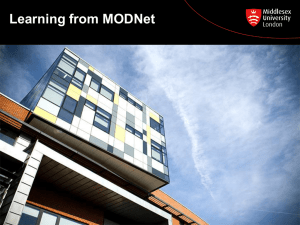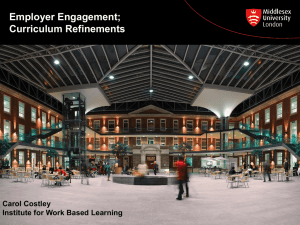his presentation - Education and Employers Taskforce
advertisement
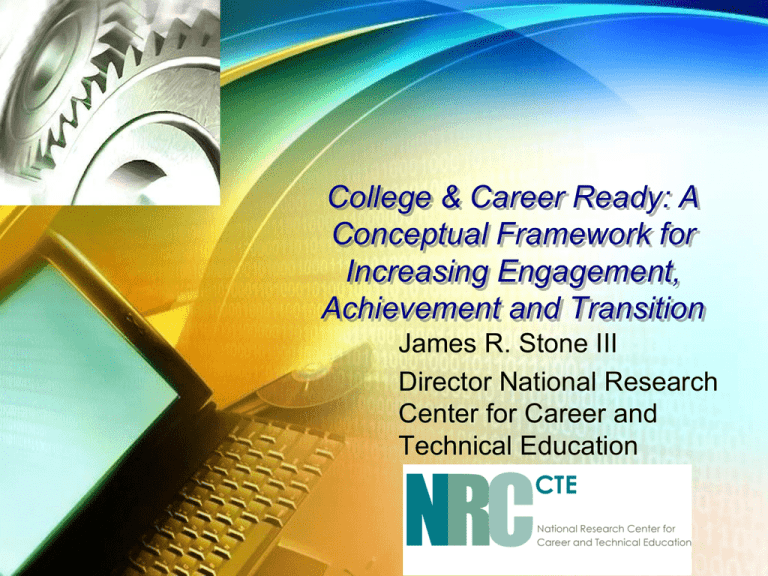
College & Career Ready: A Conceptual Framework for Increasing Engagement, Achievement and Transition James R. Stone III Director National Research Center for Career and Technical Education Seen stuck in traffic on A45 South Two Key Questions: 1. What is the appropriate mix of academic, occupational and technical skills required for the emerging labor market? 2. How can schools help students develop these skills? Defining College & Career Ready Whatever skills needed to succeed in credit bearing CC courses (Tucker, NCEE) Being ready for college means that a high school graduate has the knowledge and skills necessary to qualify for and succeed in entry-level, credit-bearing college courses without the need for remedial coursework. (Achieve Inc) 4 years of math, English; 3 years of science & social science (College Board) Skills needed for living-wage, entry level jobs are same as skill needed to succeed in college (ADP) The Education Challenge . Engagement - Completing secondary education; completing postsecondary credential . Achievement - test scores and industry recognized credentials . Transition - to continued education and training and/or the workplace THE EMERGING AMERICAN WORKPLACE More STEM or . . . S&E occupations make up only about onetwentieth (5%) of all workers (5.3% in 2018), Urban Institute, 2007 435,000 U.S. citizens and permanent residents a year graduated with bachelor's, master's, and doctoral degrees in science and engineering. Over the same period, there were about 150,000 jobs added annually to the science and engineering workforce. . http://www.businessweek.com/print/smallbiz/content/oct2007/sb20071 025_827398.htm Murray said that none of the companies she has talked with has suggested that there is a shortage of qualified chemists or life scientists. She said that employers’ greatest concern “is not numbers, it is training.” She cited the example of managers who told her they could interview hundreds of candidates for an organic chemistry position but wish they knew how to identify those candidates who “can behave collaboratively” and have the other broad competencies discussed at the workshop. She argued that the degree to which scientists have these other capabilities “really seems to be the problem.” IS THERE A SHORTAGE OF SCIENTISTS? National Research Council. (2008). Research on Future Skill Demands: A Workshop Summary. Margaret Hilton, Rapporteur. Center for Education, Division of Behavioral and Social Sciences and Education. Washington, DC: The National Academies Press. Middle Skill Credentials Pay Off Scale Score Achievement Flat or Declining in Reading, 17 year olds, NAEP 300 295 290 285 280 275 270 265 260 255 250 79% at or above modal score 70% at or above modal score Only 35% of 12th graders are proficient in 19 (38% Academic 12.9 Academic reading. proficient Credits Credits In 2009) Note: Long-Term Trends NAEP Source: NAEP 2004 Trends in Academic Progress. The College & Career Dilemma 9th Grade Cohort • Benchmarks Workforce Credentials 100 enter 9th grade* 70% complete HS1 70 complete HS 62% start college immediately2 43 Start college 1. 2. 3. Greene et al, 2006 NCHEMS, 2009 (2006) NCES, 2010 47% drop out (31% with 0 credits) 57% complete within 6 years3 30% enter as HS drop outs 25% enter as HS grad 19% enter with some college & a lot of debt 18-24% enter with college degree (6/4;3/2) *An unknown number of pre-9th graders never make it to high school College & Career Ready: 3 Domains Academic Skills & Knowledge Technical Skills & Knowledge Occupational Skills & Knowledge 1. 2. Framework Where skills are learned What Academic Skills? College Ready Academic Skills Academic Skills & Knowledge Career Ready Academic Skills Measuring College & Career Readiness College Ready? • • Career Ready (the academic side)? Using traditional assumptions (i.e., • ACT Work Readiness preparation for 4-year Assessment (based college), only 32% of HS on O’Net data) graduates are college measures: ready (Greene, 2003) • Reading for information 28% of 4-year college entrants require • Locating information remediation (NCES, 2007) • Applied math • 50% of HS grads (who take the ACT exam) are college ready (ACT, 2005) ACADEMIC SKILLS IN THE WORKPLACE Academic Skills Needed for College are the Same Needed for Careers . . . ? Career Ready (the academic side)? • ACT Work Readiness Assessment (based on O’Net data) measures: • Reading for information • Locating information • Applied math • Zone 3 Jobs, Level 5 Math Skills Career ready math for Level 5 work ACT College & Work Readiness Brief (2008) Career Ready Electronic Technician – Level 5* Requirements Fundamental knowledge of PC and Server Operating Systems. Fundamental knowledge of networking principles. Strong Electronics and Mechanical background Highly motivated and energetic Strong communication skills and work ethic Strong organizational skills Working knowledge of Microsoft Office applications Excellent troubleshooting skills Experience with IBM POS equipment Experience with Lexmark printers Experience with Toledo and Hobart scale systems Experience with Nortel BCM and Toshiba CTX systems Experience with Fujitsu Self Checkout systems Experience with Cisco routers and HP network switches Skills Tech Skills Tech Skills WBL Soft Skills Soft Skills Soft Skills Tech Skills Tech Skills WBL WBL WBL WBL WBL WBL WBL What Occupational Skills!!!!! (AKA Employability Skills) Occupational Skills & Knowledge Frameworks: SCANS, 21st Century Skills *Critical thinking *Teamwork/ collaboration *Problem solving *Creativity *Technology-information application Oral & written communication skills Responsibility Professionalism Ethics Systems knowledge Skills for the 21st Century What technical skills Immediate specific job skills* Industry certifications 132 available through HS programs (n=4 states) Technical Knowledge & Skills * Learning for jobs (OECD) The Road to an American Solution Elements of the Pathways System Core 1. Multiple Pathways 2. An Expanded Role for Employers 3. A new Social Compact with Young People Key Elements: Elevate career education to world-class levels Provide high-quality career counseling Greatly expand and improve opportunities for work-based learning Programs of Study (USDE) • • • • Incorporates secondary education and postsecondary education elements; Includes coherent and rigorous content aligned with challenging academic standards and relevant career and technical content in a coordinated, non-duplicative progression of courses that align secondary to postsecondary education; Leads to an industry-recognized credential or certificate at the postsecondary level or an associate or baccalaureate degree; and May include opportunity for secondary education students to gain postsecondary education credits through dual or concurrent enrollment programs or other means. STRATEGIES Systems CAREER PATHWAYS CAREER ACADEMIES CAREER THEMED HIGH SCHOOLS Pedagogy CURRICULUM INTEGRATION WORK BASED LEARNING CAREER-TECHNICAL STUDENT ORGANIZATIONS (CTSO) CAREER GUIDANCE What we know • Vocational education & training has been • • • • neglected* Public investment in initial VET can deliver good economic returns* Strong VET programs can increase competitiveness* Integrated curriculum builds academic skills** CTE engages students and reduces drop out rates** • *Learning for jobs OECD 2010 • **NRCCTE, 2006 High school is the last education opportunity paid for wholly by the public. It’s purpose has to be to do the best it can to provide all who leave it the foundation necessary to enter, or further prepare for, adult life. Barton, 2006 WWW.NRCCTE.ORG JAMES.STONE@NRCCTE.ORG
